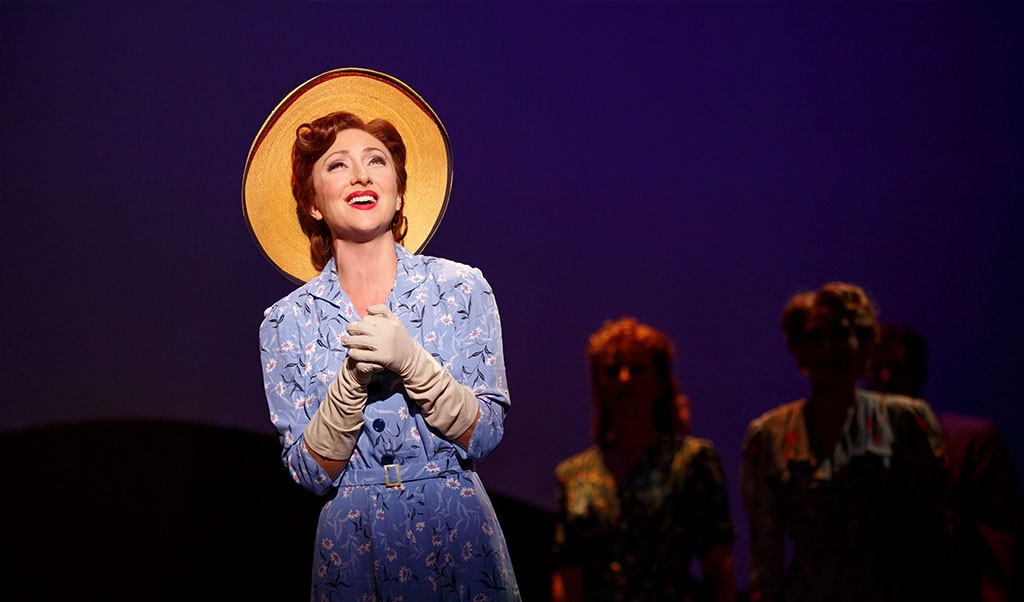To See or Not to See: Bright Star

A new star is shining on the Great White Way: Bright Star opened last night at the Cort Theatre, and it lights up the current Broadway season with feeling. It is an original musical from Steve Martin (yes, the Steve Martin) and singer-songwriter Edie Brickell. Martin and Brickell are distinguished musicians in their own right, and their collaboration on the bluegrass/folk album Love Has Come for You in 2013 earned them a Grammy. Their success in Bright Star is no less noteworthy– it is a moving show packed with lovely melodies, heartbreaking stories, and inspired performances.
Steve Martin not only co-wrote the music; he also penned the show’s book. It tells two connected stories set in the 1940s and 1920s. In the first, Billy Cane, a fresh-faced World War II vet, returns home to North Carolina with ambitions of becoming a professional writer. With the encouragement of his childhood friend Margo, Billy travels to Asheville to convince Alice Murphy, the sharp editor of a celebrated literary journal, to publish his stories. The show then rewinds twenty-odd years to tell Alice’s story. As a carefree and articulate teenager, she had fallen in love with the mayor’s son, Jimmy Ray Dobbs. And, as it usually does for young lovers, Disaster elbowed its way into their romance and made a mess of everything. Over the course of the show, we find out that Alice’s story intersects with Billy’s in astonishing ways.
Like any new musical that opens this season, Bright Star has to contend with the titan known as Hamilton. In fact, many links can be drawn between these two seemingly different shows. They are both historical musicals that straddle multiple time periods. They feature verbose, ambitious protagonists whose burdens of the past are lightened by optimism for the future. The two shows tell their stories using musical languages not often heard on Broadway– alliteratively, hip-hop for Hamilton and bluegrass for Bright Star. Both also emphasize the importance of storytelling. Finally, they are both unashamedly, emotionally sincere shows in a Broadway pool crowded with irony and cynicism (*cough*BookofMormon*cough*). Like Hamilton, Bright Star wears its heart on its sleeve.
Yet, unlike the high-minded, epic Hamilton, Bright Star‘s ambitions are gentler, and the musical’s gaze is fixed on human relationships, rather than webs of history. At its heart, Bright Star is about personal storytelling as a way to both heal and uncover truths. Specifically, it celebrates storytelling in the American South by using the music that is embedded in that region’s soul: bluegrass. Indeed, song and story coalesce in Martin and Brickell’s melodic soundtrack. The music is breathtaking at times, as lush strings blend with earthy vocals. In this way, Bright Star is special– it is the all-too-rare original musical whose songs you’ll remember long after you leave the theatre.
The real “bright star” of the show is indisputably Carmen Cusack, who makes her Broadway debut as Alice Murphy. (Ladies and gentlemen, meet your new theatre obsession.) She is, quite simply, perfection. Her warm, soulful vocal and acting gifts seem tailored to this show like a custom-made Martin guitar. She carries the show like she was born to. Her well-timed sense of humor is balanced by dramatic depth that the audience doesn’t just witness, but feels alongside her.
Cusack’s Alice has a worthy mate in Paul Alexander Nolan‘s playful and burdened Jimmy Ray Dobbs. Nolan has already distinguished himself in New York City theatre, with memorable turns in Once, Dr. Zhivago, and, most recently, Daddy Long Legs. Seeing him in Bright Star was a treat, and his performance proved that he has earned his place as a powerhouse Broadway leading man. Seeing/hearing Cusack and Nolan’s yearning duet “I Had a Vision” is a stunning reaffirmation of why we go to the theatre. A.J. Shively and Hannah Elless play Billy and Margo and bring honey-coated vocals and charm to their roles– especially in Shively’s hopeful “Bright Star” and Elless’s sweet “Asheville.” It was also lovely to see Emily Padgett, a gifted alum of the tragically short-lived revival of Side Show, in the cast and giving her all to the high-energy number “Another Round.”
The inclusion of musicians on the stage– they are literally in the middle of the story– further reinforced the show’s goal of blurring song and story. By giving the musical a predominantly string band sound, Martin and Brickell practiced the old adage “form follows function.” I had mixed feelings about the constant presence of the ensemble on stage. At its worst, the ensemble seemed to intrude and distract from the storytelling. But at its best, it amplified the sound and tight harmonies to stirring effect. The percussive choreography was repeatedly impressive and engaging, especially in the intricately-staged, rousing “Bright Star,” when the ensemble, like the Fates, ushered Billy toward his destiny.
This is a show that aches just as frequently as it moves and inspires. Do yourself a favor and see Bright Star. Let the show shine on you, and bask in its jubilant glow.
Photo Credit: Joan Marcus


Thank you for writing the most thoughtful review of this wonderful show. I saw it last week, and I was swept away by its unabashedly gentle nature. I am a sucker for sentimentality, so perhaps one should take my praise with a grain of salt. And yet…
Those of us who love the magic of Story (and song) make no apology for being moved by It’s a Wonderful Life, Miracle on 34th Street, The Sound of Music — the list goes on. For Bright Star to arrive on Broadway as an original — no book or Disney-movie tie-in! — simply makes it all the more special.
I can see how critics find some shortcomings, but to judge the show by a few weaknesses while overlooking its overwhelming appeal is just as short-sighted. Bright Star is gentle, powerful, memorable and fun, and its performances, choreography, and staging are stellar. The whole darned thing shines brightly, and though that phrase is, yes, treacly, it also happens to be the truth.
Thanks for your comment, Charlie! I’m delighted to see you proclaim your love of Bright Star. Doing so shows support for an original, moving production that deserves to reach a lot of people. I don’t know about you, but I’m already plotting my return to the Cort Theatre to see it again!
[…] Chats with Jack Cutmore-ScottTo See or Not to See: Bright StarRed Carpet Coverage: The Story of […]
[…] this may be a long shot, I’ll be rooting for Bright Star in this category. The bluegrass music got under my skin and brings a smile to my […]